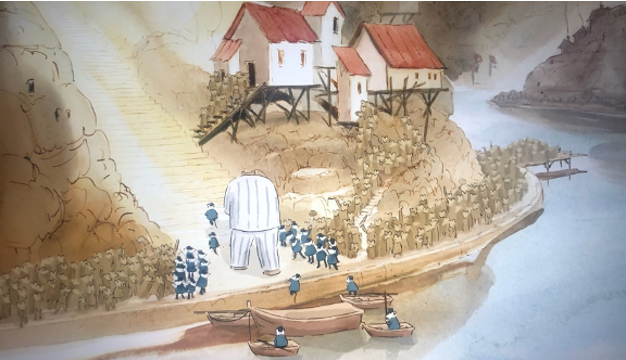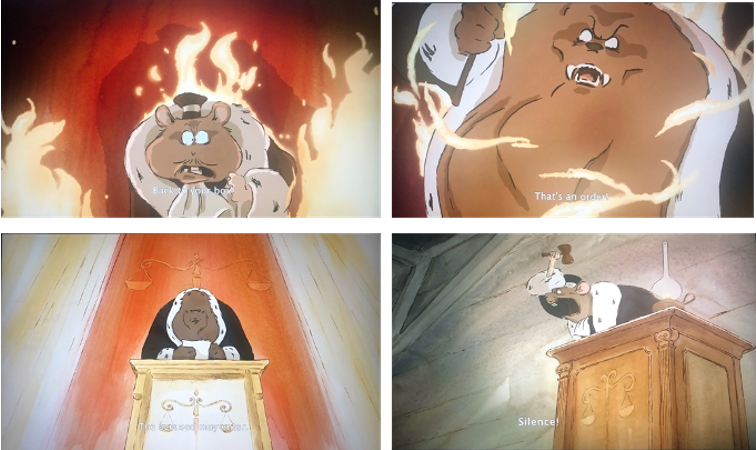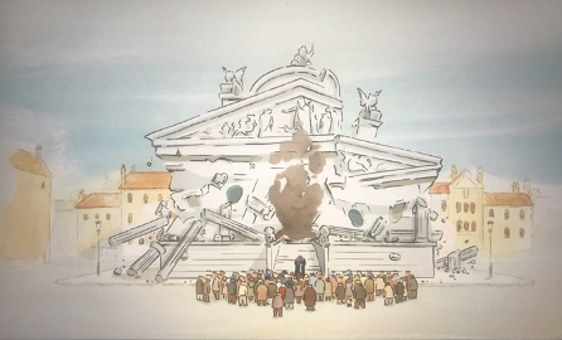The animated film Ernest and Celestine[1] (2012) uses animals to offer a socio-political examination of French society. A predator-prey construct is conveyed through the division of social classes in the species contrast between a mouse- Celestine, and a bear- Ernest. By depicting stereotypes of animality and inverting the norms to show an unorthodox friendship, Renner exposes human class limitations.
The disparity of the animals addresses taboo issues on social boundaries by portraying and destabilising norms of animality. Mice and bears are antithetical on the animal spectrum and embody juxtaposing stereotypes. Renner uses the characterisation and relationship of Ernest and Celestine to epitomise the merging of contrasting social classes. Ernest is introduced as a solitary animal on the hunt for food in the bleak town thus conveying an idea of poverty; Renner exhibits a colour shift from grey to increasingly colourful in the denouement to suggest a brighter coexistence through the integration of social classes now that Ernest can live with Celestine. The colour transition is salient as it suggests the deconstruction of animal stereotypes, Ernest is no longer alone conveying that his independent nature has been reversed.

A poignant signifier of class hierarchy is the trial scene. Mice citizens watch as Ernest is guided towards the court, the predator-prey conflict is accentuated as his prominent stature against the mice heightens the animal differences to exemplify class boundaries. The mice without authoritative positions are all brown and fuse together; the lack of distinctiveness stresses their identity as a grouped ‘nest’ society rather than individuals like bears. The blending views mice as a community and reinforces animality norms of their inferiority to both the predatory bear stereotypes and to the anthropocentric gaze of the viewer. “Nobody questions the foundations of our society, least of all a mouse!”1 stresses that the lower class has no voice against authoritarian figures; the dialogue stresses an uprising against animalistic stereotypes as both Ernest and Celestine are treated as insignificant against the embodiments of power in the society of the other species.
The pillow fight from the start is paralleled by the jury, the repetition of the sequence suggests that there is a generational reluctance to change stereotypical views on animality. Celestine calls for a re-examination on animality and suggests that “all of [them] are prejudiced”1, the attitudes to social class constraints and animal stereotypes must be altered. By using a small mouse to revolt against a larger species, Renner depicts that individuals of an inferior social class can make an impact upon society.
The transition between the two anthropomorphised judges shows that they are the same figure of capitalism. Both judicial leaders are significantly overweight compared to other characters suggesting that they encapsulate control and excess of the upper class. Renner explores the faults of having overwhelming power which is parodied through the ironic and excessive use of the justice scale symbol.
The fiery collapse of the ‘court d’appel’ highlights the collapse of class boundaries as the protagonists are proclaimed “free” and liberated from stereotypes.
References:
All screengrabs and other references are taken from:
1 Renner, Benjamin, dir., Ernest and Celestine (France: StudioCanal, 2012)



